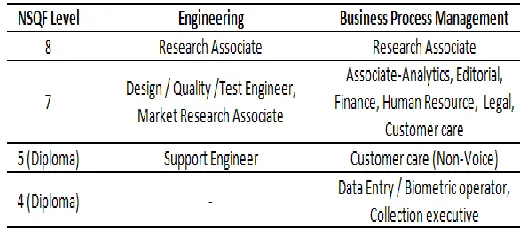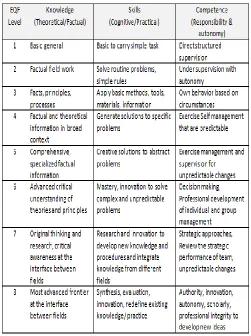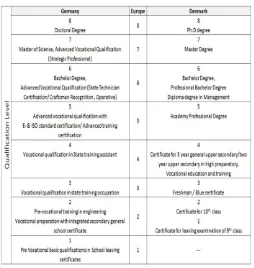187
Qualification Framework And Recognition
Krishnamoorthy A, Srimathi H
Abstract: The open economy increased attracting the talent across the word through academic and occupational mobility. The recognition of programme credibility and qualifications is important for both students and employees who seek overseas appointments. The individual country follows its own qualification framework. There is a wide disparity and challenge in judging student credentials based on different qualifications. The high in- and out- bound mobility necessitated the countries to think about standardize the national qualification framework on par with international standards and recognition. There is a need to monitor quality, transparency and accountability in national, regional and global standards towards borderless higher and skill education. The study aims to review some of the efforts across the world to standardize the qualification framework for better recognition.
Index Terms: Qualification Framework, Qualification Recognition, Migration, Occupational Standard, Vocational Education ————————————————————
1
I
NTRODUCTIONTHE qualification framework is an instrument to identify and classify degrees, diplomas and certificates according to a set of learning competencies. The number of levels in a framework varies according to national or international needs. The basis for qualification framework is to improve the quality, accessibility and labour market recognition within and outside a country. The recognition process benefits the country and institutions in setting quality benchmark, knowledge transfer and increase collaborative research capabilities. The individuals are benefited by expanding their competency level and improve living standards. The global convention on qualification recognition promotes greater opportunities towards cultural exchange and meets the expectations of sustainable development goals.Many countries do not recognize international qualification with automatic validity, as it is very difficult to understand the system of others. Each country establishes the competent authorities to recognize foreign qualification. The different recognition system is applied to higher studies / academic upgradation employment in a regulated and non-regulated profession (see Fig. 1). The applicants of higher studies are evaluated by individual institutions with reference to the broader guidelines established by country’s competent authorities. The formal recognition of qualification will minimize the challenges during study abroad and overseas employment (Hemingway, 2014). However, the greater challenge is on recognizing informal and non-formal learning in employment. Countries including India have provided options for recognition of prior learning to increase employment opportunities of Indians in formal regulated sector. The research is made on best practices of sector based, national, regional and international frameworks and the recommendations are listed for improvement.
Fig. 1. Foreign Qualification Recognition
2
SECTOR QUALIFICATIONThe sector qualification identifies the required workforce in the sector and levels of workforce. Each level describe students competency to execute the job related to mapped occupational standard . The description of each level assumes that earlier levels have been largely achieved and maintained. The sample from United Kingdom (UK) automotive sector qualification progression (SPIN360, 2013) is shown in Table 1.
Table 1. Sector Skill Qualification for Automotive Sector (Country : UK)
(a) Jobs and Workforce (b)
_________________________
Krishnamoorthy A, Professor & Associate Dean, Department of Electronics and Instrumentation Engineering, SASTRA Deemed University, Thanjavur, E-mail: ak@eee.sastra.edu
188 Qualification progression of Skilled occupations / Technicians
(Country: UK)
3
NATIONAL QUALIFICATION FRAMEWORKThe qualification framework establishment at national level in each country ensures skill map, competency level related to occupational standards and eliminate non-uniformity. For example, Australian Qualification Framework (AQF), 2007 comprises a comprehensive, consistent flexible framework, which connects school, vocational education & training and higher education levels in a coherent single framework (see Table 2). Similar to UK, the AQF also grouped according to sector. The enrollment in vocational education in the schools sector gets increased. The vocational certificates in some of the cases are issued by higher education institutions, as approved by Registered Training Organizations, where in some of the Associate Degrees are issued by approved vocational training institutions.
Table 2. Australian Qualification Framework
The All India Council for Technical Education (AICTE) developed National Skill Qualification Framework (NSQF) as given in Table 3. The qualification is aligned with respect to expected learning outcome and taxonomies to optimize the global opportunities. The flexible entry exit system and seamless migration between formal and vocation streams are yet to be realized in large scale (ADB, 2014). The involvement of industry partners on syllabus, internships and training will
enhance the employment opportunity. Similar to the countries like UK, the sector skill councils of India developed the qualification pack aligned with NSQF as given in Table 4. The higher education institutions and the approved sector skill training institutes are recommended to offer job oriented courses in each sector. The National Educational policy 2019 of India is through the proposed General Education council to create a National Higher Education Qualification Framework (NHEQF) on par with international level.
Table 3. NSQF levels : India (MHRD, 2014)
Table 4. Qualification Pack of Engineering discipline (Country : India)
3
BI-
LATERAL AGREEMENTS189 qualification from India based on earlier version of National
Assessment and Accreditation (NAAC) is given in Table 5. The World Education Services operated from North America has also worked out equivalence of bachelor degree of India based on NAAC criteria as follows: Three year bachelor’s degrees with first class from NAAC “A” grade accredited institutions will be equivalent to the United States bachelor’s degree as full undergraduate equivalency. The remaining will be considered as simple three years of undergraduate study, where students are expected to additional one more year prior to doing Masters in United States. The report on “The system of education in India”, Nordic Recognition Information Centres (2006), briefly studied the details of Indian education system with respect to curriculum, examination, degree structure, governance, affiliation, research, industry participation and accreditation to recognize Indian students in higher education institutions and labour market in three countries such as Denmark, Sweden and Norway. The growing Indian population in these three countries motivated them to ensure quality concerns of Indian education system in order to make sure the knowledge level of migrants
Table 5. Australia’s Placement Recommendations for
Bachelor’s Degree from India (Source : Emily Tse, 2012)
4
REGIONAL QUALIFICATIONAs qualification framework drives value in education through a defined learning outcome, the education system must have a comprehensive mapping of knowledge, skill and competency mapping. The mutual recognition of regional qualification improves the region to gain greater mobility for higher studies and occupation (Anthony, 2014). All countries in a region will be benefited with the facilitation of student and labour mobility for the liberalization of trade in education and training. Most of the countries consider the Regional Qualification framework as catalyst for developing national qualification framework. There are several studies including European, South African, Caribbean, Association of South East Asian, Gulf cooperation council, Transitional Qualification framework for virtual university for small states of Commonwealth, and Asia Pacific countries. Among them, the European Qualification framework (EQF) is more matured and also referred in other developments.
5.1 EUROPEAN INITATIVES
The Bologna process is developed to harmonize the qualification across European region to ensure quality and compatibility of higher education qualifications. EQF is a translation tool that helps in communication and comparison
between qualification systems in Europe with reference to learning outcomes: Knowledge, skill and competencies (see Table 6). This allows any national qualification systems and frameworks to relate to the EQF levels.
Table 6. EQF levels and learning outcomes
(https://ec.europa.eu)
The European Higher Education Area (EHEA) adopted three cycles in higher education qualifications with European Credit Transfer and Accumulation System (ECTS). (Selda, 2010) The synergy of EQF, ECTS and EHEA is given in Table 7.
Table 7. The synergy between EQF, EHEA and ECTS
190 higher education Synergies in European higher education &
research areas The secondary level credentials are reviewed to expand the access of university study. The UK placement recommendations for the secondary-level certificates have range of possibilities which include A, AS and GCSE levels with different years of study. The secondary level credential of Bologna signatory countries is equivalent to the A level in UK. Table 8 demonstrates the complexity in equivalence mapping of qualification framework in two Europe countries namely Germany and Denmark.
Table 8. Comparison of Qualification between Germany and
Denmark (https://ec.europa.eu)
As the migrants of Australia and European countries are mutual (AQF, 2014), there is a detailed comparison made between AQF and EQF for mapping the qualification framework as shown in Table 9.
Table 9. Comparison of AQF and EQF (Source : AG & EU,
2016)
5.2 ASIAN INITATIVES
The importance of “Permeable framework in Asian Higher Education system as Asian Common Credit (ACC)” was studied (Hotta, 2012) under Promoting tools for balanced mobility. Though the work was author’s individual contribution the gist of presentation helps to understand the need of Qualification Framework. The majority common tendencies (excluding few country-wide exceptions) are found as listed: 1 credit = 13-17 hours of teaching which is used for teaching hours rather than including amount of student workload with absolute grading system 4 year bachelors programme in engineering, 5-6 years in Medicine The workload varies based on lab/internship/field/theory courses China (40-45), Cambodia (45), Indonesia (46), Philippines (51)… Two semester system and 14-16 weeks of instructions per semester The list of countries grouped as per academic calendar is Brunei Darussalam, China, Japan, South Korea, Indonesia, Lao, Singapore and Vietnam Cambodia, Malaysia, Myanmar, Philippines and Thailand Some of the challenges in Asian region are: Identifying learning outcomes of the course as learning taxonomy varies which insists on describing learning outcome in course catalogue Need of uniform grading system for credit Transfer: Academic Calendar: There is a need of short-duration courses with 7-8 teaching weeks and four divisions in a year for skilling, upskilling courses. General Trends in Asia and Europe is listed in Table 10.
Table 10. General Academic Trends in Asia and Europe
(Hotta, 2012)
However, in the recent years, all the Asian countries are either contemplating / undergone revisions in their educational systems, and hence a review of the findings is required
5
INTERNATIONAL RECOGNITION191 engineering technologies called as Sydney Accord and Dublin
Accord. However, the international dimension of qualifications frameworks has not been up to date, beyond the regions and countries. There is a gradual shift from bilateral agreements to multi lateral agreements. It is the responsibility of individual nation to develop its qualification framework on par with international standards considering global political, economic, labour migration and integration processes.
6
CONCLUSIONThe globalization and technology advancements encouraged the unprecedented movement of students and professionals globally. The mobilization improves economy and widening opportunities for individuals as well as countries with larger population have a benefit of placing their skilled workforce worldwide. The receiving country also gets benefited with placing skilled candidates. This has necessitated the nations to create qualification framework mapping with labour market worldwide. To avoid the challenge of supply demand connectivity gap, the new Educational policy of India focus on both local-global competency balancing in proposed qualification framework. Considering the India’s young population workforce, the action based policy plan is required to align higher education qualification with required global skill set.
R
EFERENCES[1] ANTHONY ET AL, (2004), VISION 2020 : FORECASTING
INTERNATIONAL STUDENT MOBILITY : A UK PERSPECTIVE,
BC, IDP, UNIVERSITIES UK,
HTTPS://WWW.BRITISHCOUNCIL.ORG/SITES/DEFAULT/FILES/
VISION-2020.PDF
[2] COA, (2006), To the Mutual recognition agreement and Trans-Tasman Mutual Recognition Arrangement, https://docs.
education.gov.au/system/files/doc/other/users-guide.doc
[3] Nordic, (2006), The system of education in India, https:// norric.org/files/education-systems/India-2006.pdf
[4] AQF, (2007), AQF implementation handbook 2007,
https://www.aqf.edu.au/sites/aqf/files/aqf-implementation-handbook-fourth-edition-2007.pdf [5] Selda O, (2010), European Qualifications
Framework, National Qualifications Framework, Ministry of Working Group of Turkish QF for higher education, https://myk.gov.tr /TRR/File6.pdf
[6] Emily Tse, (2012), Approaches to International degree recognition: A comparative study, IERF, ,
http://ierf.org/wp-content/uploads/2016/01/IERFEvaluationMethodology .pdf
[7] Hotta, T, (2012), The importance of “Permeable” Framework in Asian Higher Education: Introduction of ACC (Asian Common Credit) and three new
challenges,
https://www.asem-
education.org/documents/initiatives-priority-themes/health / asem-conference-on-enhancing-balanced-mobility-2012/219-ppt-hotta-1/file
[8] ADB, (2014), Australia Aid, Innovative strategies in Technical and Vocational Education and Training for accelerated human resource development in South
Asia, , https://www.adb.org
/sites/default/files/publication/41186/innovative-strategies-technical-vocational-education-training.pdf [9] AQF, (2014), Strengths, benefits and challenges of
alignment between the Australian Qualifications framework and the European Qualifications
framework, 2014, https://international
education.gov.au/News/Latest- News/Documents/ED16-0165%20-%20693040%20-%20Joint%20Technical%20Report_ACC.pdf
[10]Hemingway, B. (2014), IOM, Recognition of qualifications and competencies of migrants, 2014, https://www.oecd.org /els/mig/Hemingway.pdf
[11]MHRD, (2014), Document for Credit Framework, Skills and education and NSQF, Department of Higher Education, MHRD, Retrieved from http://mhrd.gov.in/sites /upload_files/mhrd /files/upload_document/
Book_Credit_Framework_111114.pdf
[12]SPIN360, (2013), European Sector Skill Council :
Automotive Industry,
https://ec.europa.eu/social/BlobServlet ?docId=1879 5&langId=en
[13]Anwar AA, Richards D, (2015), The Washington Accord and U.S. Licensing Boards, Journal of Professional Issues in Engineering Education, [14]AG & EU (2016), Comparative Analysis of the
Australian Qualifications Framework and the European Qualification Framework for Life Long
Learning: Joint Technical Reports



